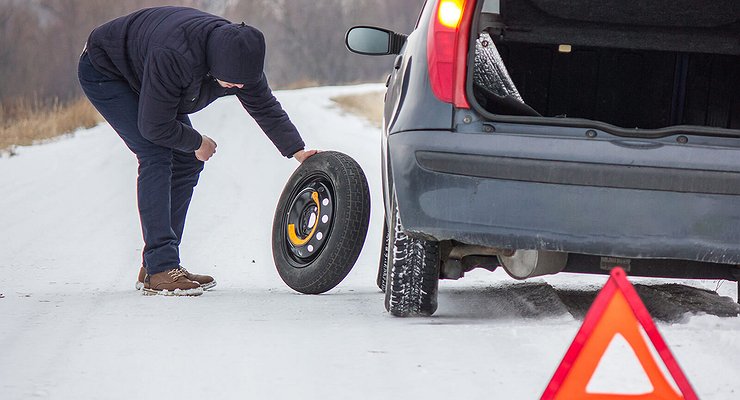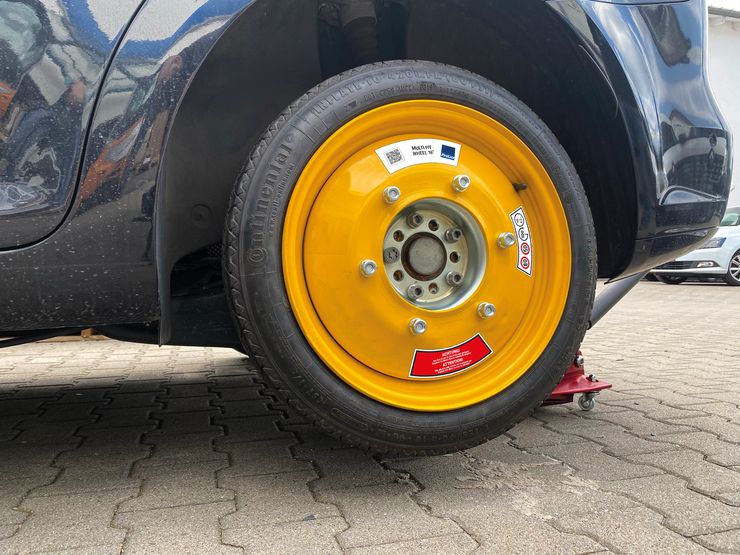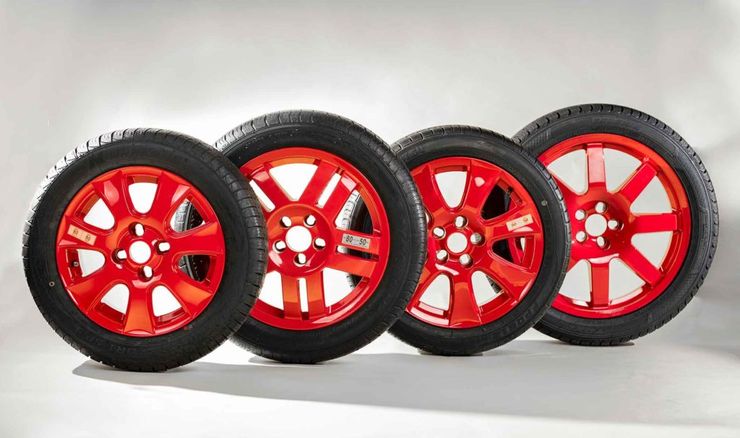Why is the use of “dokatka” especially dangerous in winter?
- January 16, 2023
- 0
Almost all motorists are faced with the problem of a flat tire in one way or another. It is clear that to solve the problem you can use
Almost all motorists are faced with the problem of a flat tire in one way or another. It is clear that to solve the problem you can use

It seems that car manufacturers design their cars for an ideal world. Where there are no problems in the form of a sudden change in weather. Where the roads are always perfectly smooth and disasters never happen. And nowhere (and nothing) to damage the tires. How else to explain that in your four-wheeled friend, as conceived by the developer, there may not be a full-fledged spare wheel at all? And instead there will be a strange kind of “dokatka”. With a tread pattern and dimensions more suited to a fat bike than a car.
This is done in order to improve the technical characteristics in the volume column of the luggage compartment. And look good against the background of competitors. In addition, you can save money on spare parts. Yet it is significantly cheaper than a full-fledged wheel. Admittedly, this saving goes laterally to the ultimate owner in the event that he punctures the wheel, especially on a wintery road. Even in summer, with a good adhesion coefficient, the use of a “dock” is limited to a speed of no more than 40 km / h.
In winter, especially in a modern car equipped with advanced safety assistants, the picture becomes completely bleak. And all due to the fact that the tread pattern and contact patch with the road of such a “spare” are fundamentally different from ordinary winter tires. And for the worse. What does this lead to? If the “stowaway” is on an axle where there is torque, even a slight push on the throttle will cause it to slip.
As a result, the stabilization system begins to actively redistribute torque with a synchronous decrease in the throttle level. Until complete shutdown. And such work of electronics will adversely affect your safety. For example, the car cannot actively accelerate. Problems can also be caused by the difference in the outside diameter of the wheels. As a result, the ABS system will not work properly or even go into emergency mode.
If a defective spare wheel is in place of the front wheel, the car will turn very badly in the opposite direction to that on which it is installed. Moreover, it is so bad that in some cases the maneuver does not take place at all. What is the result? If you decide to use the “dock” in winter, use it wisely.
In the case of front-wheel drive, it is preferable to place it on the rear axle. Even if you pierced the front wheel, it is better to spend more time and effort, but equip the front axle with standard wheels and put the “stowaway” back. This makes it possible to reach your destination without any problems. If we are talking about rear-wheel drive with a free differential, then you preferably put it forward. After all, if there is snow under the wheels, then a non-standard “spare” on the drive shaft will not even be able to move.
For most modern four-wheel drive vehicles, the rear axle is the best place for such a “spare”. Although it can also be placed in the front relatively painlessly. But do not forget that the car can now be much smaller. Therefore, at least in winter conditions and during long journeys, the AvtoVzglyad portal recommends replacing the standard “stowaway” with a normal spare wheel.
And if you still had to use his inferior fellow, do not go fast and active. Because insufficient pedaling can, in particular, lead to overheating of the transmission or brakes, as a result of which your high-tech car, technically permanently on wheels, can be immobilized.


It seems that car manufacturers design their cars for an ideal world. Where there are no problems in the form of a sudden change in weather. Where the roads are always perfectly smooth and disasters never happen. And nowhere (and nothing) to damage the tires. How else to explain that in your four-wheeled friend, as conceived by the developer, there may not be a full-fledged spare wheel at all? And instead there will be a strange kind of “dokatka”. With a tread pattern and dimensions more suited to a fat bike than a car.
This is done in order to improve the technical characteristics in the volume column of the luggage compartment. And look good against the background of competitors. In addition, you can save money on spare parts. Yet it is significantly cheaper than a full-fledged wheel. Admittedly, this saving goes laterally to the ultimate owner in the event that he punctures the wheel, especially on a wintery road. Even in summer, with a good adhesion coefficient, the use of a “dock” is limited to a speed of no more than 40 km / h.
In winter, especially in a modern car equipped with advanced safety assistants, the picture becomes completely bleak. And all due to the fact that the tread pattern and contact patch with the road of such a “spare” are fundamentally different from ordinary winter tires. And for the worse. What does this lead to? If the “stowaway” is on an axle where there is torque, even a slight push on the throttle will cause it to slip.
As a result, the stabilization system begins to actively redistribute torque with a synchronous decrease in the throttle level. Until complete shutdown. And such work of electronics will adversely affect your safety. For example, the car cannot actively accelerate. Problems can also be caused by the difference in the outside diameter of the wheels. As a result, the ABS system will not work properly or even go into emergency mode.
If a defective spare wheel is in place of the front wheel, the car will turn very badly in the opposite direction to that on which it is installed. Moreover, it is so bad that in some cases the maneuver does not take place at all. What is the result? If you decide to use the “dock” in winter, use it wisely.
In the case of front-wheel drive, it is preferable to place it on the rear axle. Even if you pierced the front wheel, it is better to spend more time and effort, but equip the front axle with standard wheels and put the “stowaway” back. This makes it possible to reach your destination without any problems. If we are talking about rear-wheel drive with a free differential, then you preferably put it forward. After all, if there is snow under the wheels, then a non-standard “spare” on the drive shaft will not even be able to move.
For most modern four-wheel drive vehicles, the rear axle is the best place for such a “spare”. Although it can also be placed in the front relatively painlessly. But do not forget that the car can now be much smaller. Therefore, at least in winter conditions and during long journeys, the portal “AvtoVzglyad” recommends replacing the usual “stowaway” with a normal spare wheel.
And if you still had to use his inferior fellow, do not go fast and active. Because insufficient pedaling can, in particular, lead to overheating of the transmission or brakes, as a result of which your high-tech car, technically permanently on wheels, can be immobilized.
Source: Avto Vzglyad
Donald Salinas is an experienced automobile journalist and writer for Div Bracket. He brings his readers the latest news and developments from the world of automobiles, offering a unique and knowledgeable perspective on the latest trends and innovations in the automotive industry.